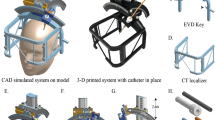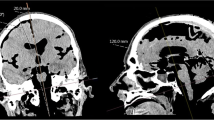Abstract
Purpose
This work exploits virtual reality technique to analyse and optimize the preoperative planning of freehand external ventricular drain (EVD) insertion. Based on the three-dimensional (3D) virtual brain models, neurosurgeons can directly observe the anatomical landmarks and complete the simulated EVD insertion. Simulation data is used to optimize preoperative planning parameters to ensure the surgical performance.
Methods
We used the computed tomography (CT) scans to construct the 3D virtual brain models. A group of EVD insertions were simulated by inserting virtual catheters at different entry points. The key parameters including the location of entry point, the catheter orientation, the catheter tip position on lateral ventricles, and the insertion depth were recorded. A data analysis method was then applied to optimize these parameters, resulting in the optimal parameters for the EVD insertion.
Results
When the lateral distance of entry point ranged from 2.5 to 3 cm, the success rate of 204 cases was 97.79%, which was higher than that of the classic method (59.52%). The optimal insertion angle towards the sagittal plane ranged from 10.46° to 12.73°. To prevent penetrating the lateral ventricles, the insertion depth was optimized to be 3.28 to 4.58 cm.
Conclusions
The proposed data analysis method is helpful to optimize the key parameters of the preoperative planning, and provides useful references for neurosurgeons to perform the freehand EVD insertion. The EVD insertion experiments on 3D printing model had a success rate of 93.75%, which verified the effectiveness of the data analysis.








Similar content being viewed by others
References
Gigante P, Hwang BY, Appelboom G, Kellner CP, Kellner MA, Connolly ES (2010) External ventricular drainage following aneurysmal subarachnoid haemorrhage. Br J Neurosurg 24(6):625–632. https://doi.org/10.3109/02688697.2010.505989
Mahan M, Spetzler RF, Nakaji P (2013) Electromagnetic stereotactic navigation for external ventricular drain placement in the intensive care unit. J Clin Neurosci 20(12):1718–1722. https://doi.org/10.1016/j.jocn.2013.03.005
Shtaya A, Roach J, Sadek A-R, Gaastra B, Hempenstall J, Bulters D (2018) Image guidance and improved accuracy of external ventricular drain tip position particularly in patients with small ventricles. J Neurosurg 130(4):1268–1273
Mortazavi MM, Adeeb N, Griessenauer C, Sheikh H, Shahidi S, Tubbs R, Tubbs R (2014) The ventricular system of the brain: a comprehensive review of its history, anatomy, histology, embryology, and surgical considerations. Childs Nerv Syst 30(1):19–35
Olson DM, Zomorodi M, Britz GW, Zomorodi AR, Amato A, Graffagnino C (2013) Continuous cerebral spinal fluid drainage associated with complications in patients admitted with subarachnoid hemorrhage. J Neurosurg 119(4):974–980. https://doi.org/10.3171/2013.6.jns122403
Li Y, Chen X, Wang N, Zhang W, Li D, Zhang L, Qu X, Cheng W, Xu Y, Chen W (2018) A wearable mixed-reality holographic computer for guiding external ventricular drain insertion at the bedside. J Neurosurg 131(5):1599–1606
Kakarla UK, Kim LJ, Chang SW, Theodore N, Spetzler RF (2008) Safety and accuracy of bedside external ventricular drain placement. Oper Neurosurg 63(suppl_1):ONS162–ONS167
Huyette DR, Turnbow BJ, Kaufman C, Vaslow DF, Whiting BB, Oh MY (2008) Accuracy of the freehand pass technique for ventriculostomy catheter placement: retrospective assessment using computed tomography scans. J Neurosurg 108(1):88–91
Yamada SM, Yamada S, Goto Y, Nakaguchi H, Murakami M, Hoya K, Matsuno A (2012) A simple and consistent technique for ventricular catheter insertion using a tripod. Clin Neurol Neurosurg 114(6):622–626
Eftekhar B (2016) A smartphone app to assist scalp localization of superficial supratentorial Lesions-Technical note. World Neurosurg 85:359–363. https://doi.org/10.1016/j.wneu.2015.09.091
Pelargos PE, Nagasawa DT, Lagman C, Tenn S, Demos JV, Lee SJ, Bui TT, Barnette NE, Bhatt NS, Ung N, Bari A, Martin NA, Yang I (2017) Utilizing virtual and augmented reality for educational and clinical enhancements in neurosurgery. J Clin Neurosci 35:1–4. https://doi.org/10.1016/j.jocn.2016.09.002
Mostofi K, Khouzani RK (2016) Surface anatomy for implantation of external ventricular drainage: some surgical remarks. Surg Neurol Int 7(Suppl 22):S577
AlAzri A, Mok K, Chankowsky J, Mullah M, Marcoux J (2017) Placement accuracy of external ventricular drain when comparing freehand insertion to neuronavigation guidance in severe traumatic brain injury. Acta Neurochir Wien 159(8):1399–1411. https://doi.org/10.1007/s00701-017-3201-5
Anderson IA, Chumas PD (2016) Neuronavigation as a diagnostic tool: an innovative application. Br J Neurosurg 30(3):351–352
Greenfield JP, Schwartz TH (2008) Catheter placement for Ommaya reservoirs with frameless surgical navigation. Stereotact Funct Neurosurg 86(2):101–105
Goldstein HE, Kennedy BC, Santos J, Anderson RC, Feldstein NA (2016) Bilateral occipital endoscopic choroid plexus cauterization for persistent hydrocephalus following frontal endoscopic third ventriculostomy and choroid plexus cauterization—the “bowling ball” technique. Childs Nerv Syst 32(4):697–701
Raabe C, Fichtner J, Beck J, Gralla J, Raabe A (2018) Revisiting the rules for freehand ventriculostomy: a virtual reality analysis. J Neurosurg 128(4):1250–1257
Bernardo A (2017) Virtual reality and simulation in neurosurgical training. World Neurosurg 106:1015–1029. https://doi.org/10.1016/j.wneu.2017.06.140
Shirk JD, Kwan L, Saigal C (2019) The use of 3-Dimensional, virtual reality models for surgical planning of robotic partial Nephrectomy. Urology 125:92–97
Yi Z, He B, Liu Y, Huang S, Hong W (2020) Development and evaluation of a craniocerebral model with tactile-realistic feature and intracranial pressure for neurosurgical training. J Neurointerv Surg 12(1):94–97
Wilson TJ, Stetler WR, Al-Holou WN, Sullivan SE (2013) Comparison of the accuracy of ventricular catheter placement using freehand placement, ultrasonic guidance, and stereotactic neuronavigation. J Neurosurg 119(1):66–70
Yim B, Gooch MR, Dalfino JC, Adamo MA, Kenning TJ (2016) Optimizing ventriculoperitoneal shunt placement in the treatment of idiopathic intracranial hypertension: an analysis of neuroendoscopy, frameless stereotaxy, and intraoperative CT. Neurosurg Focus 40(3):E12
Thomale U-W, Schaumann A, Stockhammer F, Giese H, Schuster D, Kästner S, Ahmadi AS, Polemikos M, Bock H-C, Gölz L (2018) GAVCA study: randomized, multicenter trial to evaluate the quality of ventricular catheter placement with a mobile health assisted guidance technique. Neurosurgery 83(2):252–262
Thomale UW, Knitter T, Schaumann A, Ahmadi SA, Ziegler P, Schulz M, Miethke C (2013) Smartphone-assisted guide for the placement of ventricular catheters. Childs Nerv Syst 29(1):131–139. https://doi.org/10.1007/s00381-012-1943-1
Acknowledgements
This work was supported by Natural Science Foundation of Fujian Province (Grant No.: 2019I0023), Fujian Medical University (Grant Nos.: J18011 and 2017-xq-1135).
Author information
Authors and Affiliations
Corresponding author
Ethics declarations
Conflict of interest
The authors declare that they have no conflicts of interest.
Research involving human participants and/or animals
This article does not contain any studies with human participants or animals performed by any of the authors.
Informed consent
For this type of study formal consent is not required.
Additional information
Publisher's Note
Springer Nature remains neutral with regard to jurisdictional claims in published maps and institutional affiliations.
Rights and permissions
About this article
Cite this article
Yi, Z., He, B., Deng, Z. et al. A virtual reality-based data analysis for optimizing freehand external ventricular drain insertion. Int J CARS 16, 269–276 (2021). https://doi.org/10.1007/s11548-020-02277-x
Received:
Accepted:
Published:
Issue Date:
DOI: https://doi.org/10.1007/s11548-020-02277-x




